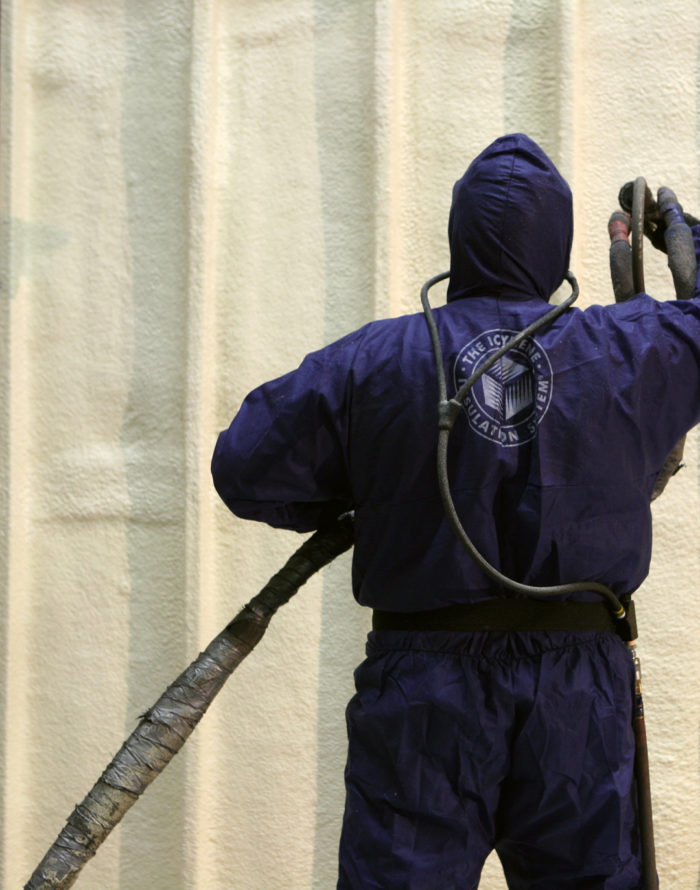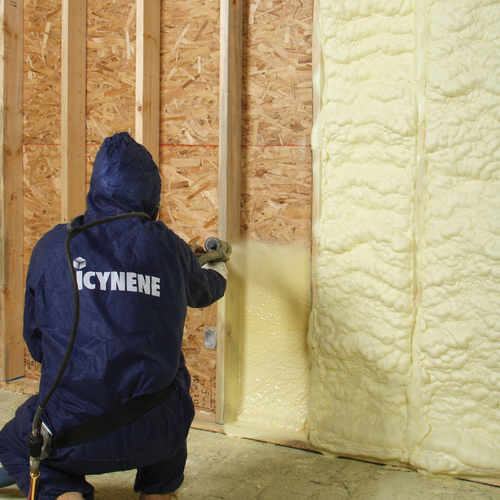
Image Credit: Icynene
Icynene has rolled out a new type of closed-cell spray insulation that uses water as a blowing agent, eliminating the global-warming potential of the hydrofluorocarbon (HFC) blowing agents in most closed-cell foams.
ProSeal Eco is described as a medium-density foam, weighing 2.2 pounds per cubic foot when cured, roughly four times as dense as Icynene’s open-cell foam and about equal to other types of closed-cell foam.
Icynene says the insulation has an R-value of 4.9 per inch, compared to R-6 to R-6.5 for closed-cell foams. But, the company adds, ProSeal Eco will show less of a drop in R-value over time than foams made with HFC blowing agents.
Icynene’s open-cell foam has an R-value of 3.7 per inch. Using those values, a 2×6 wall filled with conventional closed-cell foam would have an R-value of 35.75 (between the studs at the middle of the wall) while a wall sprayed with ProSeal Eco would have an R-value of 26.95. A wall filled with Icynene open-cell foam would have an R-value of just over 20.
Insulation can serve as a vapor barrier
A key difference between open- and closed-cell foam is how well they stop the migration of moisture into wall and roof cavities. Icynene’s closed-cell foam has a vapor permeance of less than 1 perm at a thickness of 2.4 inches, the company says, making it a Class II vapor retarder.
Open-cell foams are not considered Class II vapor retarders at any thickness.
The company says the closed-cell insulation will be helpful in exterior wall cavities, in floor assemblies over damp crawlspaces, and in walls or floors below grade where controlling dampness is important. And with a higher R-value per inch than open-cell foam, it also will be useful to builders trying to get high performance at lower thicknesses.
Improved performance comes with a higher price. Icynene didn’t offer estimates of how much more expensive ProSeal Eco would be, suggesting instead to use the dealer locator on its web site and get a local quote.
A Peabody, Massachusetts, installer said that filling a 2×6 wall with Icynene open-cell foam would cost about $2 per square foot, while ProSeal Eco would cost about $3.50 per square foot.
Weekly Newsletter
Get building science and energy efficiency advice, plus special offers, in your inbox.















5 Comments
More info please...
Scott - Do you know if this insulation needs to be applied in 2" increments as most CC or the water base allows it to install it the full cavity in one application. Are any fire hazards avoided? Health issues? Odors?
More info
Good questions, Armando.
I posed them to Icynene and got these replies:
1. Should the foam be applied in 2-in. increments? Yes, 2-in. maximum lifts.
2. Are any fire or health hazards avoided? The company is making no claims beyond the environmental benefits of switching to water as a blowing agent.
3. Any effect on odors? No. Odor "usually is related to the combination of amine catalysts in the formulation" and is not related to the blowing agent. The company says odor is typically not detectable after the first 30 days, although some people are more sensitive to smell than others.
Class-II vapor retarders and the definitions of "open cell"
At 5.5" Icynene's MD-R-200 R5.2/inch 2lb density water blown product is a minimalist class-II vapor retarder, at ~0.98 perms. At 6" it's clearly into Class-II territory. But it's being marketed as "open cell". At 5.0" (can easily be installed in 2x6 framing) it's a whopping 1.1 perms.
ProSeal Eco (designated MD-R-210) seems like just a slightly denser but lower R version of the same process, but reaches minimal Class-II vapor retardency at only 2.5".
http://www.icynene.com/sites/default/files/downloads/ProSealEco-MD-R-210%20csi%203-part%20USA%205Jul2013.pdf
http://www.icynene.com/architects/products/product-portfolio/proseal-eco-md-r-210-overview-architects
Any way you cut it, the definitions are a bit squishy. Is there magical difference between 0.9 perms (where it qualifies as Class-II) and 1.1 perms (where it is Class-III)? In practical terms, not so much. The definitions are somewhat arbitrary, and it's the order of magnitude that counts. In most 2x6 assemblies where Class-II vapor retardency is called for by code, there is no hazard (none!) using the higher R foam that comes in a 1.1 perms. Most half-pound open cell foam in a 2x6 cavity would be on the order of 6-8 perms @ 5.5", but not the MD-R-200 "open" cell foam.
Most HFC blown closed cell comes in at 0.8-1.2 perms at only 1" of thickness- at least twice as vapor retardent as ProSeal Eco, which is in-turn about twice as vapor retardent as MD-R-200. There is no hard definition of "open cell" , it's a matter of "how open is open?" The actual ASTM E 96 tested vapor retardency is more important to the design than arbitrary definitions of vapor retarder class, or open vs. closed cell. If they want to call this product closed cell and it's near-twin open, fine, but there is far less than an order of magnitude different in vapor retardency between them. They could call both of those products "clopen cell" for all I care as long as they spell out the vapor retardency explicitly.
Thank you...
Thank you both.... "clopen", eh?...LOL... You may want to trademark that word ASAP... I'll be using it in the future. Too funny!
"Clopen" has been long-since taken...
...a least in the set-theory mathematics sense. In set theory the definitions of an open-set and closed-set do not preclude the other, and a set that satisfies both is referred to as "clopen". (My math-nerd background bubbles forth once again- least I'm doing SOMETHING with the math degree! :-) )
With spray foam there are no hard definitions open or closed cells (beyond the individual cell, I suppose)- but applying the term from mathematics here seems appropriate, since these products could be viewed as either open-cell, closed-cell, or both in different contexts.
Log in or create an account to post a comment.
Sign up Log in